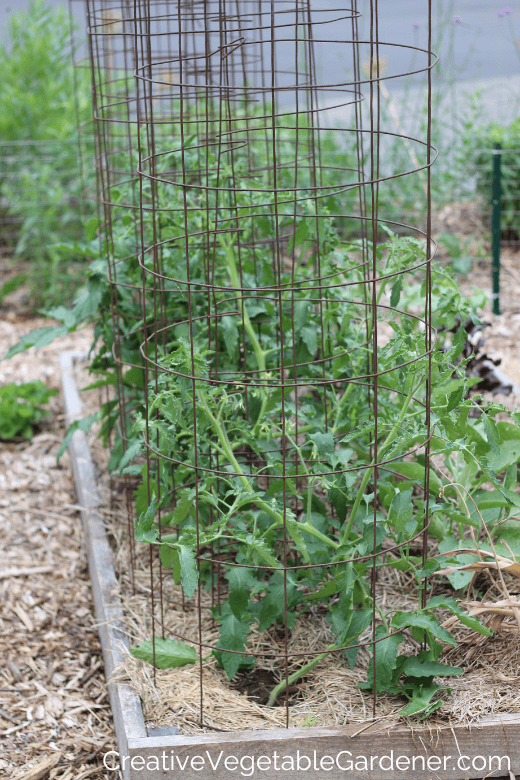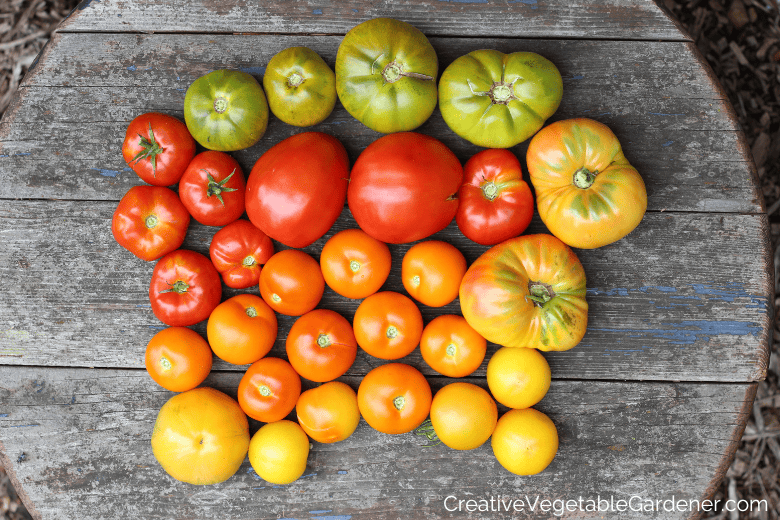I know we all agree, there’s nothing quite like the taste of a homegrown tomato straight from the garden! No wonder it’s one of the most popular vegetables grown by gardeners.
Since you’re probably counting down the days until your first harvest, you’re likely wondering how long does it take for tomatoes to grow?
It depends!
Most full size tomatoes like paste, slicers, roma, and plum varieties take between 65-85 days until the first harvest.
Cherry tomatoes take less time to grow, 50-60 days depending on the variety. In my garden, my Sun Gold cherry tomatoes are always the first to ripen, usually in early July. That’s when I do my summer happy dance to celebrate!
The best way to find out when you can expect a harvest from the varieties you’re growing is to look them up online. Each entry on a seed or plant company’s website should feature how many days until harvest. See the Growing Information section on this listing for Sun Gold cherry tomato on Johnny’s Selected Seeds website for an example.
This number is just a guideline though, because there are other factors that influence how long it takes for tomatoes to grow, such as:
- the late spring and summer weather where your garden is located
Tomatoes thrive in hot weather and warm soil temperatures, so if your spring and early summer tend to be cool this could slow down the growth of the plant and the ripening of the fruit.
- how much sun your garden gets
Tomatoes prefer full sun – about 8-10+ hours/day. If you’re garden is partly shady or your tomatoes are planted in a location that doesn’t receive full sun this could inhibit their growth.
If you have full sun and the weather is warm, your tomato plants should be deep green and growing rapidly once summer hits. If this isn’t the case, it’s possible that your soil is lacking in essential nutrients. This is not uncommon! Because all vegetables have a lot of nutrient demands, I recommend adding an organic garden fertilizer when planting.
The variety you’re growing combined with a few other factors will dictate when you get your first ripe tomato of the season.

Tomato Plant Growth Timeline Explained
Now that you have a better idea of when the tomato varieties you’ve planted are likely to produce, let’s make sure you’re familiar with the stages of tomato growing. This is an important factor in answering the question of how long does it take for tomatoes to grow.
Planting
After your average last frost is when you should transplant your tomatoes into the garden. Tomatoes do not like cold weather or soil and can be damaged or killed if the temperature dips below 32 degrees F.
I recommend planting transplants, not seeds, because you’ll get a harvest much quicker. If you live in a cold climate like mine your plants may not have time to grow and ripen lots of fruit before your first frost if you plant them by seed straight into the garden.
Read more about how and when to transplant tomatoes.
And if you feel overwhelmed by the hundreds of varieties out there, here are my guides on how to plant different varieties of vegetables and how to choose the best tomato varieties.
Adjustment
Newly planted seedlings often go through transplant shock. During this time make sure they have plenty of water because their root system is very small since the plant just came out of a pot. I mulch my tomatoes right after planting to trap in soil moisture, suppress weeds, and help cut down on disease.
When you start to notice the plant growing and putting out new leaves, that’s a sign that it’s established its root system and is ready to start pumping energy into growth. Hooray!
Read more about ways to prevent tomato disease.

Growth
Once the air and soil temperatures have warmed up in summer tomato growth explodes! You can almost watch them grow by the minute.
If you’ve planted indeterminate varieties, these plants can grow huge and unwieldy as the season progresses. That’s why I always spend some time pruning indeterminate tomatoes early in the season.
Determinate varieties are much smaller plants and don’t require pruning.
During this early growth phase is also when you should make sure your tomatoes are trellised. Because indeterminate varieties can grow to 8’ tall [or more], they need high and sturdy support. I also use cages for my indeterminate varieties so the tomatoes don’t end up laying on the ground and rotting.
Here’s how to use tomato cages and my favorite DIY tomato cage option.
Flowering + Pollination
It’s super exciting when I notice the first tiny yellow flowers on my tomato plants because I know ripe tomatoes aren’t too far off in the future. During this stage of the tomato growth timeline, make sure your plants are well watered to support flowering.
Tomatoes are self-pollinating plants. Their flowers contain both male and female reproductive parts. But, wind and insects can help the process along, so make sure you’re not spraying chemicals in your yard or garden and planting plenty of flowers to invite pollinators to hang around.
Fruit Growth + Ripening
This final stage of the tomato growing timeline is the most rewarding! First you’ll notice that your plants are forming small, green tomato fruits. As the weeks progress they’ll grow larger and start to ripen into red, yellow, orange or other interesting color you’ve planted.
We’ll talk more below about how to know exactly when to harvest tomatoes.

How Tall Do Tomato Plants Grow?
There are two types of tomatoes – determinate and indeterminate.
Indeterminate tomato plants continue to grow throughout the entire season and set fruit on the new growth right up until the plants are killed by frost. My indeterminate tomatoes often grow up to 10 feet tall! You definitely need to cage these varieties, no question about it.
To help control some of this wild growth, I spend some time early in the season pruning indeterminate tomatoes.
Determinate tomatoes include the bush varieties and are more compact than the taller (indeterminate) plants. They grow to be about 3-5’ tall depending on variety. They produce a lot of fruit on shorter stems that ripen in a short window of time. This means that there’s a lot of opportunity for the fruit to become too heavy for the stems to bear. Then your plants are likely to sag or possibly even break.
You should cage determinate varieties as well.

How Long Do Tomato Plants Produce?
Now that you understand determinate and indeterminate tomatoes, we can dive into how long they each produce.
Indeterminate tomato plants keep growing and putting on new flowers and fruit until they’re killed by your first frost in cold climates. That means you’ll get fruit for 2, 3 or more months depending on where you live.
That being said, in my garden in Wisconsin by the end of September the weather is chilly and the days are short. Sure, my tomato plants are still alive, but they’re looking rough. The leaves are often mottled by disease and turning brown, and the tomatoes that are left aren’t getting very big or ripening quickly. The fruit that does ripen doesn’t taste as good as the tomatoes of July and August.
It’s around this time that I find myself starting to tire of tomatoes and moving onto my favorite fall vegetables like beets, carrots, salad mix and daikon radishes. I usually leave my tomato plants in the garden until my first frost in October, but honestly, I’m usually relieved when it comes so I can clean out that part of the garden.
Determinate varieties produce a harvest in a shorter window, over 2-4 weeks. This is great if you like preserving your tomatoes and you want a large amount all at once. It’s not as great if you’d rather have more of a prolonged harvest. I plant mostly indeterminate varieties because I like to have tomatoes all season, but I also mix a few determinate plants since they ripen earlier.

When To Harvest Tomatoes
The first important piece of information you need around when to harvest tomatoes is what color it is when it’s ripe. Knowing whether your tomato should be red, orange, purple, or yellow is key.
If you’re not sure what color tomato you’re growing, look up the variety on the internet to find out.
When an individual tomato is uniformly red [or other color], grab it and give it a little tug. If the fruit is ripe, it should easily release from the plant. If you are having to twist the tomato free, or apply a lot of pressure, the tomato isn’t quite ready.
If you harvest your tomatoes slightly underripe, no worries! You can keep them on your kitchen counter for a few days to let them really develop their flavor.
Tomato harvest starts to pick up pace as the weather heats up. Checking in daily on your garden is an important task that only gets more critical when the harvest speeds up.
If you’re growing lots of cherry tomatoes learn more about when to pick cherry tomatoes.

What To Do With Too Many Tomatoes
I used to grow 40 tomato plants in my garden! What was I thinking? Of course, I often ended up with crates and crates of ripe tomatoes. I’ve reformed myself though, and nowadays I only grow 12-15 tomato plants each season.
Growing more tomatoes than you can possibly eat is not uncommon since they’re such productive plants. So, what to do with too many tomatoes?
They’re one of the easiest vegetables to preserve for winter eating. And totally worth it since winter grocery store tomatoes are practically tasteless.
My favorite technique for preserving tomatoes entails cooking them down, skins and all, and freezing them in containers. I use these in any recipe that calls for canned tomatoes. I haven’t bought a canned tomato product from the grocery store in years! Read all about my favorite for preserving tomatoes.
You can also freeze tomatoes raw, which I don’t like as much, but I share two techniques for doing so in this article about how to preserve tomatoes.
There are many reasons why almost every gardener out there plants at least one tomato each season – they’re easy to grow, produce a ton of fruit, and the flavor is above and beyond what you could ever find in a grocery store.
Now that we’ve answered the question how long does it take for tomatoes to grow, you’ll likely agree hat the 85 days you may have to wait until you pick your first ripe tomato is definitely worth it!
